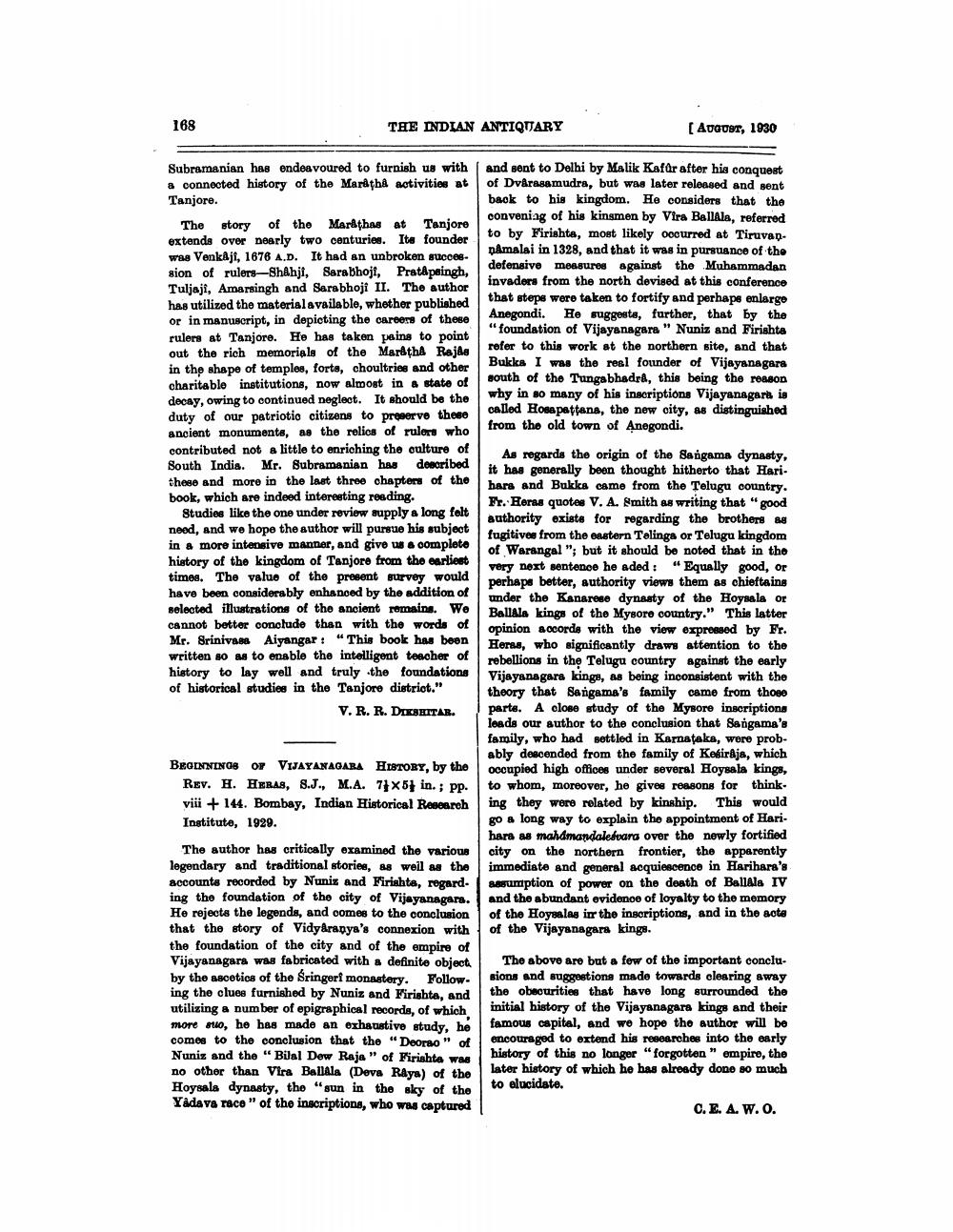________________
168
THE INDIAN ANTIQTJARY
[ August, 1930
and sent to Delhi by Malik Kafür after his conquest of Dvarasamudra, but was later released and sent back to his kingdom. He considers that the conveniag of his kinsmen by Vira Ballala, referred to by Firishta, most likely occurred at Tiruvan. påmalai in 1328, and that it was in pursuance of the defensive measures against the Muhammadan invaders from the north devised at this conference that steps were taken to fortify and perhaps enlarge Anegondi. He suggests, further, that by the "foundation of Vijayanagara " Nuniz and Firishta refer to this work at the northern site, and that Bukks I was the real founder of Vijayanagara south of the Tungabhadra, this being the reason why in so many of his inscriptions Vijayanagara is called Hosapattana, the new city, as distinguished from the old town of Anegondi.
Subramanian has endeavoured to furnish us with & connected history of the MarathA activities at Tanjore.
The story of the Marathas at Tanjore extends over nearly two centuries. Its founder was Venkaji, 1676 A.D. It had an unbroken succession of rulers-Shahji, Sara bhoji, Pratápsingh, Tuljaji, Amarsingh and Sarabhoji II. The author has utilized the material available, whether published or in manuscript, in depicting the careers of these rulers at Tanjore. He has taken paine to point out the rich memorials of the Maratha Rajas in the shape of temples, forta, choultries and other charitable institutions, now almost in a state of decay, owing to continued neglect. It should be the duty of our patriotio citizens to preserve these ancient monuments, as the relics of rulers who contributed not a little to enriching the culture of South India. Mr. Subramanian has devoribed these and more in the last three chapters of the book, which are indeed interesting reading.
Studies like the one under review supply a long felt need, and we hope the author will pursue his subject in a more intensive manner, and give us a completo history of the kingdom of Tanjore from the earliest times. The value of the present survey would have been considerably enhanced by the addition of selected illustrations of the ancient remains. We cannot better conclude than with the words of Mr. Srinivasa Aiyangar : “ This book has been written so as to enable the intelligent teacher of history to lay well and truly the foundations of historical studies in the Tanjore district."
V. R. R. DIKSHITAR.
As regards the origin of the Sangama dynasty, it has generally been thought hitherto that Harihars and Bukka came from the Telugu country. Fr. Heras quotes V. A. Smith as writing that "good authority exists for regarding the brothers as fugitives from the eastern Telinga or Telugu kingdom of Warangal"; but it should be noted that in the very next sentence he aded : “Equally good, or perhaps better, authority views them as chieftains under the Kanarese dynasty of the Hoysala or BallAls kings of the Mysore country." This latter opinion accordo with the view expressed by Fr. Heras, who significantly draws attention to the rebellions in the Telugu country against the early Vijayanagara kings, as being inconsistent with the theory that Sangama's family came from those parte. A close study of the Mysore inscriptions leads our author to the conclusion that Sangama's family, who had settled in Karnataka, were probably descended from the family of Kesiråja, which occupied high offices under several Hoysala kings, to whom, moreover, he gives reasons for thinking they were related by kinship. This would go a long way to explain the appointment of Harihara as mahamandalesvara over the newly fortified city on the northern frontier, the apparently immediate and general acquiescence in Harihara's sasumption of power on the death of BallAla IV and the abundant evidence of loyalty to the memory of the Hoysalas irr the inscriptions, and in the acts of the Vijayanagara kings.
BEGINNINGS OF VIJAYANAGARA HISTORY, by the
Rev. H. HERAS, 8.J., M.A. 77X51 in.; pp. viii + 144. Bombay, Indian Historical Research Institute, 1929.
The author has critically examined the various legendary and traditional stories, as well as the accounts recorded by Nuniz and Firishta, regard. ing the foundation of the city of Vijayanagara. He rejects the legends, and comes to the conclusion that the story of Vidy&ranya's connexion with the foundation of the city and of the empire of Vijayanagars was fabricated with a definito object by the ascetics of the Sringeri monastery. Follow ing the clues furnished by Nuniz and Firishta, and utilizing a number of epigraphical records, of which more mio, he has made an exhaustive study, he comes to the conclusion that the "Deorao" of Nuniz and the "Bial Dew Raja" of Firishta was no other than Vira Bailala (Deva Raya) of the Hoysala dynasty, the "sun in the sky of the Yadava rece" of the inscriptions, who was captured
The above are but a few of the important conclusions and suggestions made towards clearing away the obecurities that have long surrounded the initial history of the Vijayanagara kings and their famous capital, and we hope the author will be encouraged to extend his researches into the early history of this no longer "forgotten" empire, the later history of which he has already done so much to elucidate.
C.E.A.W.O.




